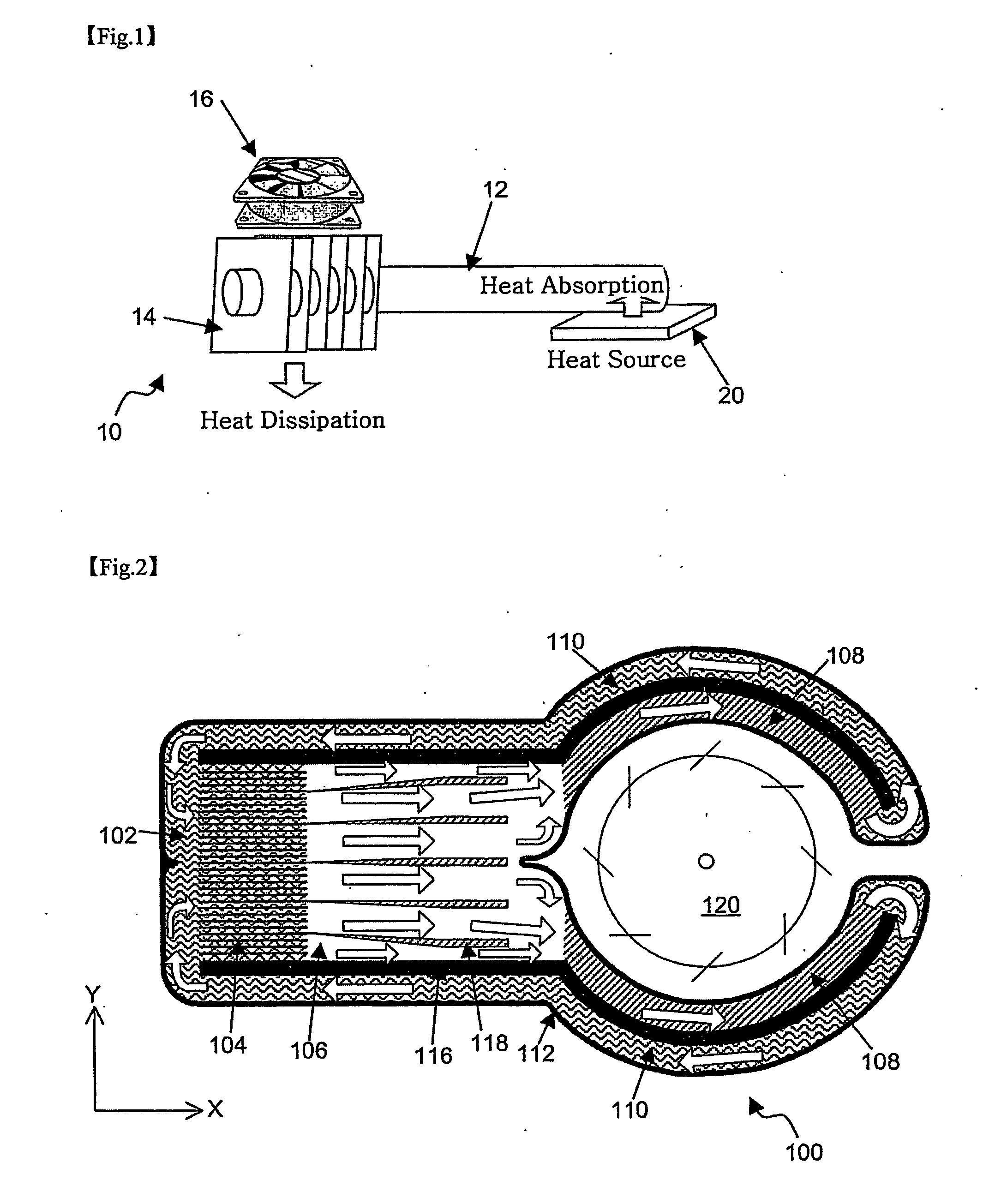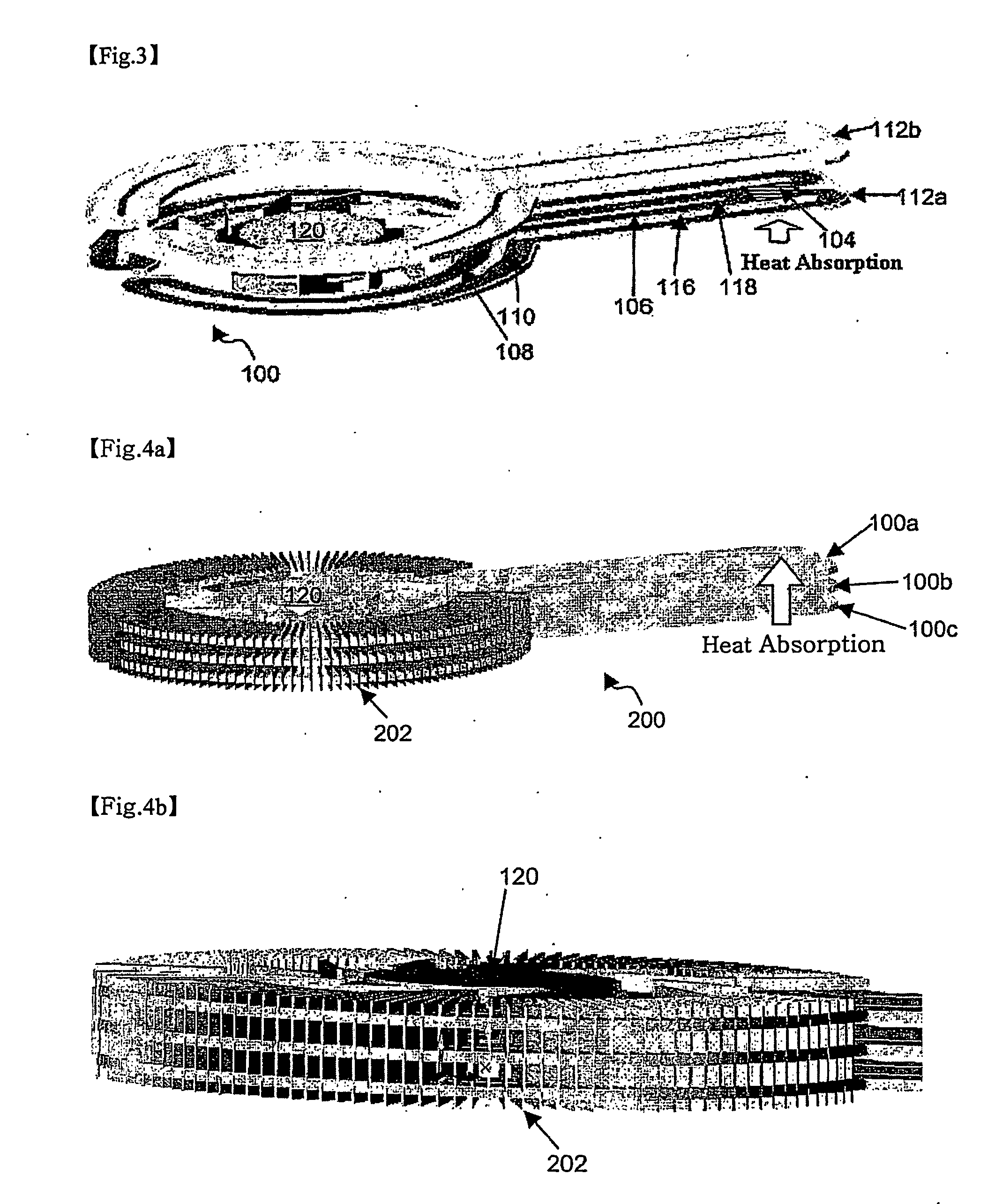Cooling device of hybrid-type
a cooling device and hybrid technology, applied in the direction of air heaters, indirect heat exchangers, light and heating apparatus, etc., can solve the problems of reducing the life expectancy, deteriorating the performance of semiconductor devices, and increasing the heat emission ratio of semiconductor devices per unit area, so as to improve cooling performance and minimize heat loss
- Summary
- Abstract
- Description
- Claims
- Application Information
AI Technical Summary
Benefits of technology
Problems solved by technology
Method used
Image
Examples
first embodiment
[0030]FIG. 2 shows a horizontally cross-sectional view of a hybrid cooling device according to the present invention. As shown in FIG. 2, the hybrid cooling device 100 of this embodiment includes a phase transition cooler 112 in which a circulation loop of a refrigerant capable of phase transition is formed, in at least a part of the circulation loop including a section (hereinafter, “branching section”) in the shape of a hollow ring, and a fan 120 being disposed in the hollow of the branching section of the phase transition cooler.
[0031] A housing of the phase transition cooler 112 can be manufactured of a material such as semiconductor, e.g. Si, Ga, etc., a novel substance-laminated material, e.g. Self Assembled Monolayer (SAM), metal and / or alloy, e.g. Cu, Al, etc. with high conductivity, ceramic, a high molecular substance, e.g. plastic, a crystalline material, e.g. diamond. Particularly, in case of a semiconductor chip as the external heat source, the housing can be made of the...
second embodiment
[0056]FIG. 4a shows a perspective view of a hybrid cooling device 200 according to the present invention, and FIG. 4b shows an enlarged perspective view of a condensation section of the hybrid cooling device 200. As shown in the drawings, a plurality of phase transition coolers 100a, 100b and 100c are arranged vertically in this embodiment. The heat from the external source is transferred to a region corresponding to the evaporation sections of the phase transition cooler 100a, 100b and 100c respectively in the thick arrow direction. For this, a heat transfer substance can be inserted between the phase transition coolers 100a, 100b and 100c.
[0057] In this embodiment, a plurality of fins 202 are radially formed outside the condensation sections of the phase transition coolers 100a, 100b and 100c, and a fan 120 is disposed in the middle space. Accordingly, unlike the conventional heat pipe module, the temperature distribution inside the fins is uniformly maintained, which maximizes t...
third embodiment
[0058] Next, FIG. 5a shows a perspective view of a hybrid cooling device 220 according to this invention, and FIG. 5b is a side view of the hybrid cooling device 220 in FIG. 5a. As shown in the drawings, the cooling device 220 in this embodiment is formed by bonding the sections including the refrigerant storage sections and the evaporation sections of the phase transition coolers 100a, 100b and 100c shown in FIG. 4a. The sections including the condensation sections are not bonded but separated so as to maximize the ventilation effect by the fan 120, and the side structure of the phase transition coolers of the lowest and middle layers are consequently modified a little.
[0059] Meanwhile, in this embodiment, the liquid state refrigerant transfer sections near the evaporation sections and the evaporation sections, each of which is included in the three layer phase transition coolers, may be formed in common rather than independently. In this case, a predetermined region branches verti...
PUM
| Property | Measurement | Unit |
|---|---|---|
| phase transition | aaaaa | aaaaa |
| thermally insulating | aaaaa | aaaaa |
| thermal insulation | aaaaa | aaaaa |
Abstract
Description
Claims
Application Information
 Login to View More
Login to View More - R&D
- Intellectual Property
- Life Sciences
- Materials
- Tech Scout
- Unparalleled Data Quality
- Higher Quality Content
- 60% Fewer Hallucinations
Browse by: Latest US Patents, China's latest patents, Technical Efficacy Thesaurus, Application Domain, Technology Topic, Popular Technical Reports.
© 2025 PatSnap. All rights reserved.Legal|Privacy policy|Modern Slavery Act Transparency Statement|Sitemap|About US| Contact US: help@patsnap.com



